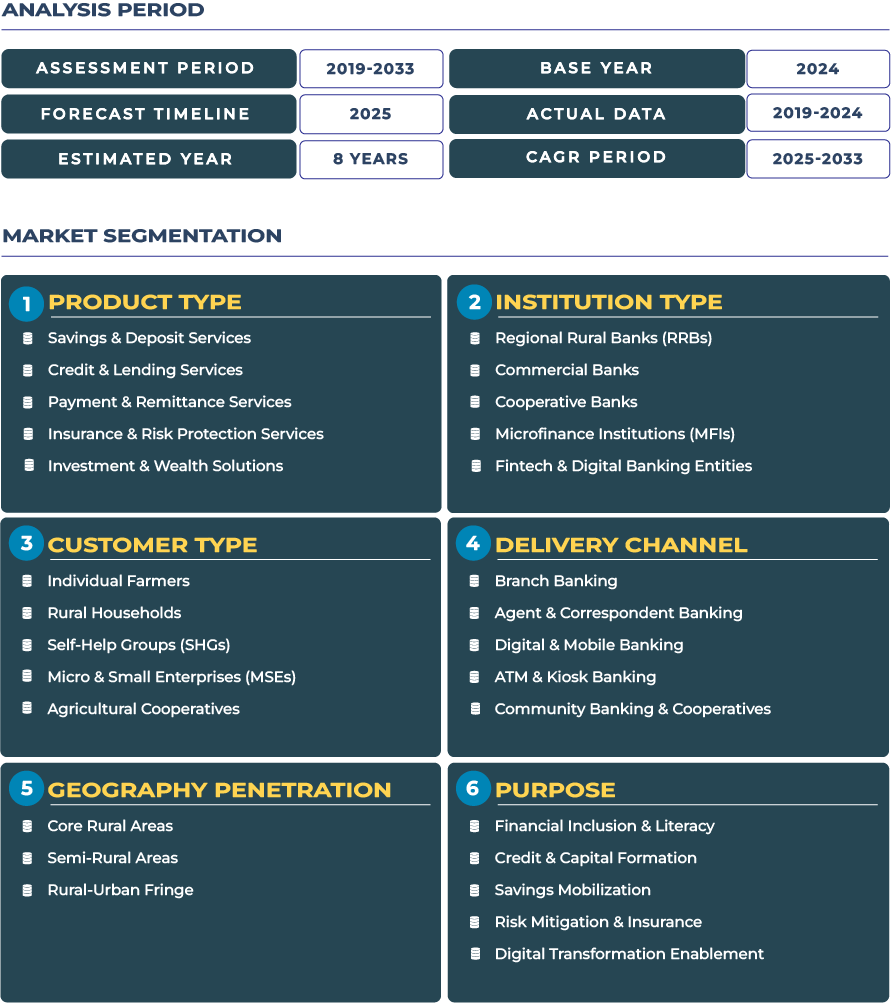Cooperative Digitalization and Machinery Leasing: Redefining Germany Rural Banking Landscape
Germany rural banking market stands at a pivotal juncture where tradition meets technology. The country’s deep-rooted cooperative banking heritage, anchored in the Sparkasse and Volksbanken Raiffeisenbanken networks, is embracing digital transformation to strengthen rural competitiveness. As cooperative banks modernize their systems through digital lending tools, fintech integrations, and open banking frameworks, the rural economy gains access to faster credit disbursal, flexible deposit services, and sustainable financing instruments. This convergence between cooperative ethics and digital innovation is ushering in a more inclusive financial ecosystem for rural Germany.
Note:* The market size refers to the total fees/revenue generated
Germany Rural Banking Market Outlook – Cooperative Networks Powering Digital Rural Revitalization
The outlook for Germany rural banking industry is underscored by the strategic interplay between regional cooperative banks and digital finance modernization. The Deutsche Bundesbank reports that cooperative and savings banks collectively manage over 60% of SME and agricultural lending in rural Germany, signifying their critical economic footprint. Post-pandemic, these institutions have expanded credit access to small and mid-sized agribusinesses, diversified farming ventures, and renewable energy cooperatives. This co-op-centric model enhances rural liquidity while preserving localized control of capital.
The modest CAGR conceals significant qualitative progress. With EU’s Common Agricultural Policy transition and domestic emphasis on digital inclusion, rural banking institutions are broadening access to credit and digital deposit services for regional producers and farm-linked SMEs. Moreover, geopolitical shifts following the Russia-Ukraine war have elevated the importance of localized agricultural self-reliance, stimulating credit demand for machinery leasing, farm storage, and bioenergy facilities. Cooperative banks, supported by the Federal Ministry for Economic Cooperation and Development (BMZ), have been instrumental in deploying structured loans and insurance products aligned with rural innovation and sustainability goals. The German rural banking landscape, therefore, remains stable, technologically progressive, and resilient amid European economic uncertainty.
Drivers & Restraints – Balancing Heritage Stability with Regulatory and Operational Challenges
Growth Driver – Strong Cooperative Networks and Farm Credit Integration
Germany rural banking sector thrives on its robust cooperative network foundation. The Sparkassen and Volksbanken institutions, operating through thousands of rural branches, maintain long-standing relationships with regional producers, local industries, and family-owned farms. Their integrated credit mechanisms, ranging from savings and deposit services to machinery finance, enable consistent access to affordable credit. In addition, cooperative governance encourages risk-sharing, allowing banks to underwrite larger volumes of agricultural and SME loans compared with private commercial banks. The Deutscher Raiffeisenverband (DRV) continues to promote contract farming and digital agrifinance partnerships that sustain the rural banking ecosystem’s growth momentum by linking financial services with production chains and value-added agriculture.
Growth Restraint – Regulatory Rigidity and High Compliance Costs in Rural Lending
On the downside, the rural banking market in Germany is constrained by high operational and compliance costs associated with stringent KYC and Basel III requirements. Many regional cooperative banks find it difficult to extend high-risk credit to micro-enterprises due to limited collateral and rigid risk-weight frameworks. Moreover, Germany’s conservative credit culture often discourages experimental financing models for start-ups and technology-driven agribusinesses. The consolidation of smaller cooperatives further reduces competition and innovation. These structural rigidities, coupled with rising compliance expenses and workforce shortages in rural areas, moderate the overall growth potential of the rural banking sector despite strong digital investments.
Trends & Opportunities – Technology-Driven Agrifinance and Cooperative Modernization
Trend Evolution – Digital Cooperative Platforms and High-Tech Machinery Financing
Rural banking trends in Germany increasingly reflect a blend of tradition and innovation. Cooperative banks are launching digital platforms for credit assessment, machinery leasing, and supply-chain payment automation. The Sparkassen-Finanzgruppe has introduced several mobile banking applications that enable farmers to manage loans and insurance digitally. This aligns with the broader European movement toward open-banking compliance, which enhances transaction transparency and reduces turnaround time for loan approvals. Another key trend is the emergence of equipment-financing partnerships that support mechanization among small and medium-sized agricultural enterprises, particularly in Bavaria, Lower Saxony, and Baden-Württemberg. These initiatives improve productivity while embedding financial discipline through digital repayment systems.
Opportunity Expansion – Factory-for-Farm Leasing Models and Credit Linked to Cooperative Memberships
New opportunity corridors are emerging as banks experiment with factory-for-farm leasing programs and cooperative-linked credit guarantees. These models reduce upfront capital expenditure for rural entrepreneurs while deepening loyalty within cooperative structures. The inclusion of cooperative membership as a credit enhancement mechanism allows banks to reduce default risk through community trust and mutual liability. Furthermore, financing linked to renewable energy installations, biogas, solar, and wind assets on rural land, is expanding the portfolio of investment and wealth solutions in the rural banking sector. Germany’s ongoing green-transition strategy, backed by the Federal Ministry for Economic Affairs and Climate Action (BMWK), is expected to catalyze financing of decentralized renewable projects, amplifying rural banks’ roles as sustainability enablers.
Competitive Landscape – Strategic Collaborations and Market Re-Alignment in Rural Banking
The competitive landscape of Germany rural banking industry reflects both local strength and global entry. Cooperative leaders such as Sparkasse, Deutsche Raiffeisenbank Gruppe, and DZ Bank continue to dominate regional markets through digital reinvestment and community-based lending models. In September 2025, JPMorgan Chase announced plans to launch its digital retail bank “Chase” in Germany by Q2 2026, signalling an expansion into regional and rural banking segments. This entry intensifies competition in digital payment and remittance services, encouraging local banks to modernize technology infrastructure and improve customer engagement strategies.
Emerging strategies include:
- Launching cooperative-backed lease-to-own machinery plans that reduce capital strain for rural enterprises while promoting asset modernization.
- Integrating cooperative membership verification as a credit-risk enhancement tool, ensuring community accountability and lower default ratios.
Together, these approaches reinforce Germany’s distinctive model of rural financial inclusion, where social capital, digital transformation, and sustainable lending converge to define the future of the rural banking landscape.








